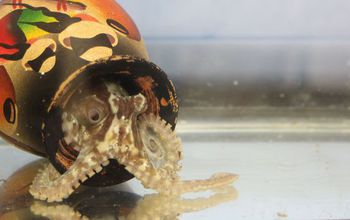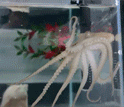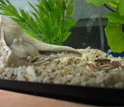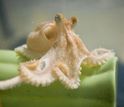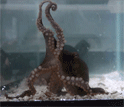News Release 15-089
First-ever octopus genome sequenced
Research will enable future studies on brain development
August 12, 2015
This material is available primarily for archival purposes. Telephone numbers or other contact information may be out of date; please see current contact information at media contacts.
Multiple serpentine arms, a bulbous head, the ability to change color: No wonder the octopus is often compared to an alien creature.
Turns out, its uniqueness extends beyond those external characteristics. In the first-ever sequencing of the entire octopus genome, researchers discovered unusual features that shed light on octopus evolution and biology, and set the stage for future studies on complex nervous system development.
Published today in Nature, the research reveals striking differences between genome of the octopus and other invertebrates. Those include huge expansions in two families of genes previously thought to be unique to vertebrates, and a complex gene arrangement. The research was funded in part by the National Science Foundation (NSF).
The work was conducted by teams from the University of Chicago, University of California Berkeley and the Okinawa Institute of Science and Technology as part of the Cephalopod Sequencing Consortium.
The sequencing revealed some definite surprises in the octopus genome, said Clifton Ragsdale, principal investigator on the NSF award and an associate professor at the University of Chicago.
"But we expected to be surprised," he said. "These are such remarkable animals."
Ragsdale and his team sequenced the genome of Octopus bimaculoides, the California two-spot octopus. The researchers mapped gene expression profiles in 12 different tissues, and identified 33,000 protein-coding genes, which puts the octopus genome at slightly smaller in size than the human genome.
Octopuses, along with squids and cuttlefish, are cephalopods, a class of marine invertebrates with an evolutionary history spanning more than 500 million years. They have some of the most sophisticated behaviors in the animal kingdom: large, highly-developed brains capable of learning and problem-solving (like opening a food-filled jar, for example). They also have a suite of unique physical traits: the ability to regenerate complex limbs, camera-like eyes--which make them excellent hunters--and a sophisticated camouflage system.
Scientists have known about the special characteristics of octopuses for years, but this is the first time their potential origin has been traced to specific gene families, said James Deshler, a division director in NSF's Biological Sciences Directorate.
"This research is going to kick off new studies," Deshler said. "It serves as an example of how to apply modern molecular, cellular and genomic techniques to advance our understanding of the nervous system in general, and will enable others to adapt that knowledge to other aspects of brain-related research."
One of biggest surprises in the octopus genome was the expansion of two gene families, including the protocadherins, which regulate neuronal development. It was previously thought that only vertebrates possessed numerous and diverse protocadherins; they are crucial in setting up the wiring of the mammalian nervous system. The researchers found that protocadherins are 10 times more common in octopus genes than in mammals.
The other gene family, zinc-finger transcription factors, play a role in nervous system function and development. The octopus genome has 1,800 of these transcription factors--the second-largest gene family discovered so far in animals.
Yet besides these two dramatic expansions, octopus gene families are similar to other invertebrates. What's not similar is their arrangement. The octopus genome "looks like it's been in a Cuisinart," Ragsdale said. Different genes are placed in different genomic environments, which mean different regulatory elements affect the genes.
Ragsdale and his colleagues are now studying the molecular and genetic mechanisms responsible for octopus development.
"Once we pass into a post-genomic age, as we have for octopus, it opens a whole new range of questions, and new abilities to ask how the nervous system is organized, how it develops," he said.
Applying modern genomic technology to cephalopods also allows remarkable animals like octopuses to become a kind of model organism for studying brain function and development.
"The approach of my lab is to start bringing modern molecular cellular neurobiology to questions about cephalopods," Ragsdale said. "We wouldn't have been able to do this without NSF support."
NSF has a broad portfolio of brain-related investments; cross-disciplinary research aimed at understanding the full complexity of the brain, in action and context. Learn more here.
-NSF-
-
An octopus crawls up the side of its tank.
Credit and Larger Version -
A young octopus fights a crab.
Credit and Larger Version -
A juvenile California two-spot octopus descending from his perch.
Credit and Larger Version -
An octopus displays its color-shifting ability.
Credit and Larger Version
Media Contacts
Jessica Arriens, NSF, (703) 292-2243, email: jarriens@nsf.gov
Kevin Jiang, The University of Chicago, (773) 795-5227, email: kevin.jiang@uchospitals.edu
The U.S. National Science Foundation propels the nation forward by advancing fundamental research in all fields of science and engineering. NSF supports research and people by providing facilities, instruments and funding to support their ingenuity and sustain the U.S. as a global leader in research and innovation. With a fiscal year 2023 budget of $9.5 billion, NSF funds reach all 50 states through grants to nearly 2,000 colleges, universities and institutions. Each year, NSF receives more than 40,000 competitive proposals and makes about 11,000 new awards. Those awards include support for cooperative research with industry, Arctic and Antarctic research and operations, and U.S. participation in international scientific efforts.
Connect with us online
NSF website: nsf.gov
NSF News: nsf.gov/news
For News Media: nsf.gov/news/newsroom
Statistics: nsf.gov/statistics/
Awards database: nsf.gov/awardsearch/
Follow us on social
Twitter: twitter.com/NSF
Facebook: facebook.com/US.NSF
Instagram: instagram.com/nsfgov

